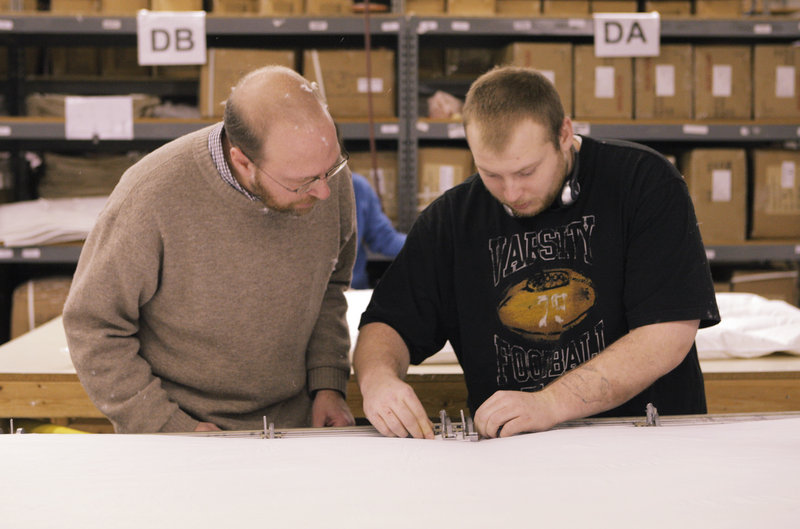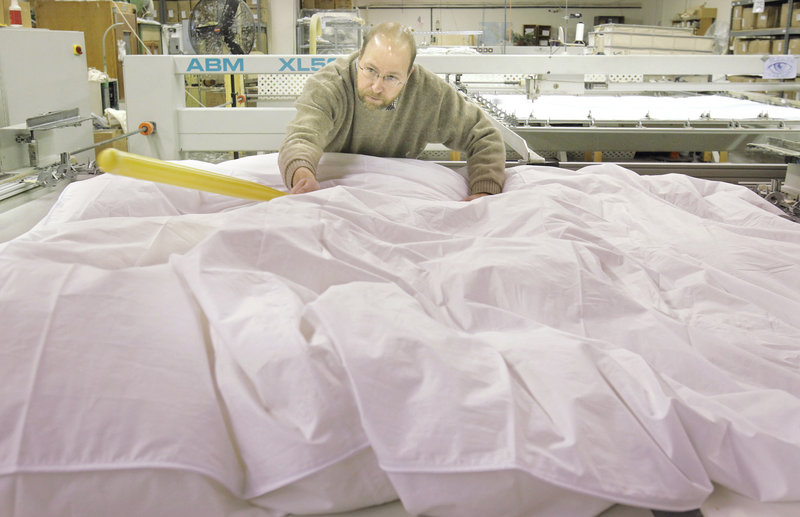PORTLAND – John Roode had placed a down-filled pillow on a scale, showing a weight of about 885 grams, or at least 5 grams less than it was supposed to be.
So he asked me to scoop some of the feathery down from a cardboard box on the floor to make up the difference.
But when I clenched my fist to grab some down, most of the little flecks flew in the air, leaving me with basically down residue on my hands. It was like trying to grab a bunch of snowflakes as they fell to the ground.
I tried to grab a bigger clump — again and again — and finally gave up. I put the little bit of down I could actually grab into the pillow, and the scale barely budged. It took me about three more tries before I got 5 grams more into that pillow.
When I was done, I realized that my wool sweater had collected more pieces of down than my hands had.
“Yeah, wool is probably not the best for this job. I usually wear a T-shirt,” said Roode, 26, a machine operator at Cuddledown, a pillow and comforter manufacturer on Canco Road in Portland. “And I still get it on me. You can’t avoid it.”
It was quickly explained to me on the Cuddledown factory floor that “down” is not synonymous with “feathers.” I thought I’d be handling feathers, or at least pieces of feathers. But at Cuddledown, Roode and others told me, “down” means the very fine, very soft substance found on the front of the neck of a goose or a duck. Because it’s so light and so fine, it’s not the easiest substance to work with.
At one point Roode and I were filling king-sized pillowcases using a machine that had a long tube hung about 5 feet in the air, with the opening pointing downward. Roode had me use a metal clamp to fasten the pillowcase to the tube.
Then I tapped a foot pedal, which turned on the machine that blew the down through the tube into the pillowcase.
Behind the tube, I could see the 15-foot-high metal silo where the down was stored. A lighted window in the silo showed that a bar with little pieces of metal on it was continuously spinning to keep the down fluffed.
Once the pillowcase was filled, after about 30 seconds, the machine automatically clicked off. So I unfastened the clamp to take off the pillow. As I did this, I was again covered with a light snowfall of down, which came bubbling out of the pillow.
“I’d let it settle for about five seconds before taking it off,” said Roode.
I did three or four more pillows, successfully, but got a static shock each time. It seems floating down creates a lot of static electricity.
“Yeah, no way to avoid that,” said Roode when I told him about the shocks.
Much of the down at Cuddledown, I learned, comes from goose or ducks raised on farms for food. But some of the rarer down they use is collected from abandoned nests in Iceland and Scandinavia.
Comforter and pillow prices in the Cuddledown catalog range widely, with many, if not most, priced somewhere in the hundreds of dollars. But I was told the company has made comforters priced in the thousands, including one at around $9,000.
Much of the work on the comforters required a lot of attention to detail. For instance, Roode spends much of his time operating a giant machine — the size of two pool tables or longer — that stitches the quilted pattern of the comforters. When he gets a comforter, it’s basically a big, loose bag of down. (Some of Cuddledown’s comforters have synthetic fill.)
So his first job is to spread the comforter out and even out the fill. Given how light and airy down is, this is not that easy. Roode and other workers use plastic baseball bats to move the down around, first poking big clumps around, then using the bat more like a cake-frosting utensil to spread it evenly.
When I tried this, I found that I couldn’t get the down distributed evenly. Every time I moved some in one direction under the comforter cover, I left a big vacant space in another part of the comforter.
“You want to just sort of drag the bat on top in a circular motion,” said Nick Richards, another machine operator at Cuddledown.
After Richards had smoothed out the spots I couldn’t, we both dropped to the floor and scooted under the quilt. On our backs, we used the bats to smooth out the underside as well. The light from the ceiling shone through the comforter, making it easier to see where down had clumped up and needed to be smoothed.
While we smoothed one comforter, another comforter was being stitched on the machine. At one point, Roode inspected a stitched comforter and found a couple of places where the stitching hadn’t taken. So he replaced a small bobbin of thread, pushed some buttons on the machine and restitched the areas that needed it.
After the comforters are stitched, they go to another station where they are inspected for hanging threads, smoothed again and blown with an air hose to get little wisps of down off, and up into the air.
It’s probably the only workplace I’ve ever been in where down is actually up.
Staff Writer Ray Routhier can be contacted at 791-6454 or at:
rrouthier@pressherald.com
Send questions/comments to the editors.





Success. Please wait for the page to reload. If the page does not reload within 5 seconds, please refresh the page.
Enter your email and password to access comments.
Hi, to comment on stories you must . This profile is in addition to your subscription and website login.
Already have a commenting profile? .
Invalid username/password.
Please check your email to confirm and complete your registration.
Only subscribers are eligible to post comments. Please subscribe or login first for digital access. Here’s why.
Use the form below to reset your password. When you've submitted your account email, we will send an email with a reset code.